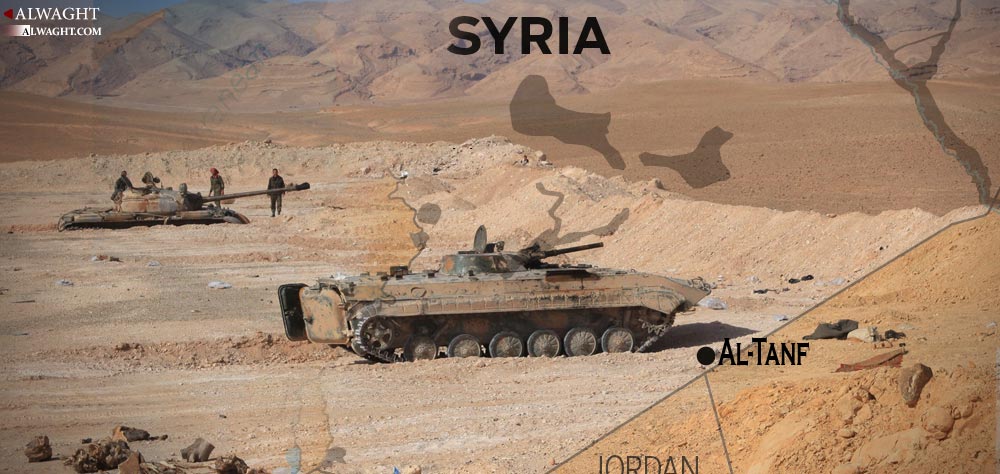Alwaght- Syrian forces battling ISIS terrorist group have once again been targeted by US-led coalition airstrike near al-Tanf border crossing s in the country’s south.
Al-Tanf is a major path on the Syrian-Iraqi borders, lying on a highway connecting the Iraqi capital Baghdad to the Syrian capital Damascus. The crossing is now under control of the militants of the Free Syrian Army (FSA) who are both trained and armed by the US and Britain.
The US-led coalition claimed in a statement on Tuesday that the Syrian forces had entered the so-called de-escalation zones near the border with Jordan and Iraq despite several warnings.
"Despite previous warnings, pro-regime forces entered the agreed-upon de-confliction zone with a tank, artillery, anti-aircraft weapons, armed technical vehicles and more than 60 soldiers," the statement said.
"The coalition issued several warnings via the de-confliction line prior to destroying two artillery pieces, an anti-aircraft weapon, and damaging a tank," it added.
The Tuesday incident is the second time in less than a month that US coalition forces have attacked Syrian government forces in al-Tanf border crossing.
Damascus has not issued a response to the latest US’ aggression which comes as Syrian government troops launched a major offensive against ISIS terrorists in their Raqqa stronghold.
Last month, the US-led Coalition carried out a similar attack killing several Syrian military personnel that were advancing against the so-called Free Syrian Army (FSA) units in southeast Homs.
Reasons behind the attack
Foreign backed terrorist and militant groups have suffered heavy blows during last year in the warn-torn country. The losses were apparent in cities such as Aleppo in north, Palmyra in west, and the Eastern Ghouta in south of the country.
Following their heavy losses elsewhere, the terrorists, backed by various foreign sides, launched a retaliatory assault in Hama in central Syria to take further areas there. But they faced a tough response from the government forces and sustained big casualties that forced them back to the north of the city. The terrorists' conclusion after the defeat was that if they act against the government forces directly, they will receive further defeats and thus will see the battlefield equations changing against their interests.
They, thus, decided that they have to resort to implementation of the already-designed US plan. The plan seeks cutting the strategic border area in smaller pieces if the militants fail to repel the Iraq and Syrian forces' advances. The final goal is to prevent Iraq, Syria, Iran, and Lebanon from linking to each other in a vast geographical area.
If such a link is materialized in the region, the four countries can focus on obliteration of terrorism, something stripping the West, Arab states, and the Israeli regime of their play cards on the ground. This is not the only outcome. The West is afraid that such a connection and triumph of the Iran-led camp will pose challenges to the allied regimes.
So deployment of troops to the Iraq-Syria as well as Syria-Jordan border areas and expansion of US presence in northern Iraq and in Syria, particularly in Al-Hasakah, Deir ez-Zor, and Raqqa provinces, under the cover of supporting the Kurdish People’s Protection Units (YPG) are coming as new developments. In fact, the US is struggling to take the initiative through taking under control some areas in a bid to manipulate the course of events in Syria.
Knowing it well that the US plan is not yet completely put into action, the pro-Damascus Resistance forces have begun taking preventive measures. The US reacted to their efforts to foil the plan and therefore launched the aerial raid near Al-Tanf border crossing.
The progress of anti-terrorist forces towards the Syrian and Iraqi borders means a spell breaker in the eyes of Washington. Actually, if the Syrian forces head to the borders with Iraq or if the Iraq forces do the same job, connection of Iraq and Syria will spoil the American strategic plan to strengthen its bases on the two countries' borders. Therefore, the Thursday night airstrike can be considered as a warning signal by the Americans.
The limited nature of the US attacks on pro-government forces can also suggest that the measures were demands by the US from the Resistance camp to allow Washington tighten its control over the border points without any escalation.
The analysts maintain that al-Tanf attacks make it clear that the pro-Syrian forces have moved in the right direction towards the right target to react to the US-designed plan for the Syria-Iraq border areas. The Syrian and Iraqi forces look quite determined to take back the geopolitically-important border areas. They very likely will continue moves to foil the US schemes for the shared borders and for the whole region.
The Resistance camp is now fully assured that if the US fails to firm up its foothold on the borders, it along with its Western allies will not be able to have its plans yielding results.



























